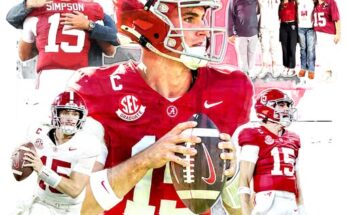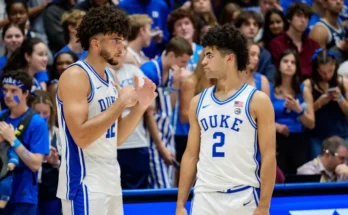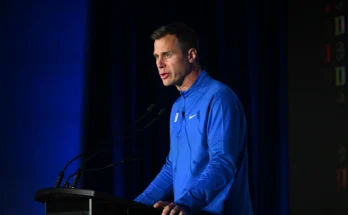Injuries to Cuevas, Pritchett make Alabama football’s smallest spring position even smaller.
When Kalen DeBoer took over as Alabama’s head coach in the aftermath of Nick Saban’s legendary run, he knew he’d inherit immense pressure, national attention, and a locker room brimming with expectations. What he didn’t anticipate, however, was just how quickly one position group would test the program’s resilience this spring. Alabama’s tight end room—already the thinnest position group entering 2025 spring practice—has been hit hard by the injury bug, with Josh Cuevas and Marshall Pritchett now officially ruled out for the remainder of the spring.
These setbacks leave Alabama with a tight end corps that’s not just inexperienced, but numerically scarce. For a team with championship aspirations and an offense looking to build cohesion under new leadership, this spring has become an unexpected stress test of depth and adaptability.
The Roster Reality
The situation wasn’t ideal to begin with. Alabama came into spring ball with only five scholarship tight ends, a number that already placed the group among the smallest in the program. Then came attrition. Robbie Ouzts and CJ Dippre both declared for the NFL Draft following the 2024 season, leaving behind sizable production and leadership gaps. Ty Lockwood, another promising piece, entered the transfer portal. Then came the news that sophomore Danny Lewis Jr. would miss the spring with a lower-body injury.
That alone would have stretched most programs thin. But when news broke that Josh Cuevas—the presumed starter—and early enrollee Marshall Pritchett would also miss the rest of the spring due to undisclosed injuries, the tight end room shrunk from shallow to skeletal.
“We’re certainly thin there,” DeBoer acknowledged in a recent press conference. “We had a lot of excitement about what Josh (Cuevas) could bring. And we still do, just not this spring.”
Cuevas: The Next Man Who Can’t Be Next (Yet)
Josh Cuevas transferred to Alabama from Washington prior to the 2024 season, following DeBoer and tight ends coach Nick Sheridan. He arrived with solid experience from the Pac-12 and, in limited action last year, showed flashes of being a versatile asset in both blocking and pass-catching. He notched 16 catches for 218 yards, demonstrating good hands, sharp route running, and a willingness to do the dirty work in the trenches.
This spring was supposed to be his time to emerge as TE1, setting the tone for a new-look offense. Now, the focus shifts to rehabilitation and fall camp.
“Obviously, it’s disappointing,” said Cuevas. “You put in the work all offseason hoping to build timing and chemistry. But this team has depth in character, even if we’re light on numbers.”
Cuevas is expected to be healthy in time for summer workouts and fall camp, but his absence in the spring means valuable reps and development are now being redistributed—or in some cases, simply unavailable.
Pritchett’s Untimely Setback
Marshall Pritchett was one of the crown jewels of Alabama’s 2025 recruiting class. A 6-foot-5, 235-pound pass-catching tight end from Georgia, he came to Tuscaloosa with comparisons to former greats like Irv Smith Jr. and O.J. Howard. His early enrollee status was a strategic move—get a head start on the playbook, strength program, and most importantly, competition.
But with Pritchett now out alongside Cuevas, the Tide are left with a razor-thin depth chart that includes only redshirt freshman Jay Lindsey and walk-on Peter Knudson as available bodies at the position.
“We were really excited about Marshall’s progress,” said Sheridan. “He was picking things up quickly and had already shown flashes of high-level play. It’s frustrating, but part of the game.”
The Last Man Standing: Jay Lindsey
That leaves Jay Lindsey as the de facto leader in the tight end room for the remainder of the spring. A former three-star recruit from Mississippi, Lindsey redshirted last season and came into spring with modest expectations. Now, he’s been thrust into a critical role—getting first-team reps, absorbing a full playbook, and, perhaps most importantly, staying healthy.
Lindsey has embraced the challenge. “There’s no time to feel sorry for the situation,” he said. “This is an opportunity for me to grow faster than I thought I’d need to.”
He’s also benefiting from added attention from the coaching staff. Sheridan has reportedly spent significant time with Lindsey one-on-one, focusing on footwork, blocking technique, and film study. Coaches have praised his maturity and work ethic.
Walk-Ons and Wild Cards
With the scholarship tight end room in tatters, Alabama has had to lean on unconventional options. Walk-on Peter Knudson has taken second-team reps, and there’s even been speculation that offensive tackles or fullbacks could be flexed into tight end-like roles in certain formations. Hybrid packages, creative blocking schemes, and even four-wide receiver looks are being explored to compensate.
One assistant coach, speaking anonymously, said, “This is going to force us to innovate a bit. You never want to be in this spot, but it’s a good test of our offensive adaptability.”
There’s also buzz that the staff may look to the transfer portal post-spring, depending on how the injury recoveries go and how confident they feel in the young guys by May.
What It Means for the Offense
Tight ends have historically played a major role in Alabama’s offensive identity, from O.J. Howard’s game-breaking speed to Irv Smith’s versatility and Miller Forristall’s reliability. With the shift to DeBoer’s offensive system—which heavily utilizes tight ends in the passing game—the position is even more critical.
At Washington, DeBoer and Sheridan helped develop tight ends into key playmakers, and the expectation was they’d do the same at Alabama. But without available bodies, those schematic aspirations must be adjusted—for now.
Quarterback Jalen Milroe, returning for his final season, had begun developing chemistry with Cuevas and Pritchett during early drills. Now, that rhythm must be reestablished later in the year, potentially slowing early-season offensive execution.
“It changes things,” Milroe admitted. “But that’s what spring is for—figuring out how to adapt.”
Incoming Help on the Horizon
The good news? Reinforcements are coming. Kaleb Edwards, a top-100 recruit from Texas, will arrive on campus in the summer. At 6-foot-4 and 240 pounds, Edwards is physically ready to compete early. If he can digest the playbook quickly, he may be a candidate for immediate playing time.
In addition, Lewis Jr. is expected to be healthy by fall. A physical blocker with upside in the passing game, Lewis could slide into a rotational or starting role if his recovery stays on track.
There’s also the transfer portal, which reopens in April. Don’t be surprised if Alabama looks to add an experienced body as insurance.
“We’ll evaluate where we’re at after spring,” said DeBoer. “We’re always going to look to strengthen our roster.”
Bigger Picture: Spring Scrutiny and Fall Focus
These spring setbacks, while inconvenient, come with a silver lining. They provide invaluable reps for younger players and force the staff to plan creatively. There’s also a belief within the program that dealing with adversity now can pay dividends later.
“We’re building a culture of adaptability,” DeBoer said. “Championship teams are forged in the spring, not just in the fall. How we respond to this will shape who we become.”
It’s also worth noting that many of Alabama’s tight end concerns could be resolved by September. If Cuevas, Pritchett, and Lewis all return healthy, the group could go from barren to deep in a matter of months. Add in the promising Edwards and a possible transfer, and suddenly the picture changes.
Spring Struggles, But Not Panic
For now, though, Alabama must navigate the rest of spring practice with what little they have. The injuries to Cuevas and Pritchett have amplified existing concerns at a crucial position, but they’ve also opened doors for players like Lindsey to grow and for the staff to flex its creativity.
Injuries are never ideal—but they’re also part of the game. At a place like Alabama, expectations don’t go away just because players do. The standard remains the standard.
And if this spring teaches Alabama anything, it’s that depth isn’t just a luxury—it’s a necessity.



